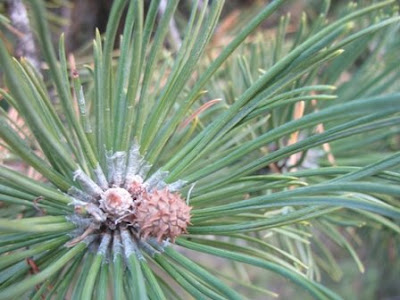
The Nordmann Fir tree (species name: Abies nordmanniana) is a popular Christmas tree species because of its dark green color, its dense foliage, its rounded needles and its drought resistance which keeps the needles from falling off too soon.

This fir tree species that also goes by the names Caucasian fir or Turkish fir is an evergreen coniferous tree native to the mountains from Turkey to the Rusian Caucas region. I took these photographs in the small ski resort town of "La Molina" in the Pyrenees mountains of Catalunia, Spain. The altitude at this location is 1700 meters above sea level.

As you can see from these images the needle like leaves have a different color pattern on the top and the bottom of the leaves. On the top side they are a solid dark green while on the bottom side they have two whitish lines down each side (another way to describe it is that there are white on the bottom with a dark treen border and a green line down the middle of the flat leafe. These leaves were about 2cm long. Notice also that the leaves are rounded on the ends and even have a slight apex like notch as the ends of some of the leaves.

The cones of this fir species grow at the top of the tall trees but I was able to find a shorter tree with cones where I could get close enough to get a few good images. From what I have read these cones change color as they mature. These young cones had an almost dark blue-green color. The lighter brown colored "exserted bracts" are another distinctive feature of this tree.

The scales of these cones detach and fall off while the stem of the cone remains in the tree. Notice also that these cones grow quite vertical and straight. It is quite common to see a good number of these empty stems on the branches near the top of these trees.

The bark of the Nordmann fir is light gray in color and fairly smooth with blister like bumps.

For a
fir tree that is native to Spain check out the "
Spanish fir - Abies pinsapo".
 The Vine Maple (tree species name: Acer circinatum) is a small maple tree species native to the Northwestern United States and I have seen on many occasions in and around Portland and Seattle. The images in this posted were taken from trees in both of these cities. The leaves in full autumn color are from a tree in North Seattle and the green leaves come from a tree in the Mount Tabor park in Portland. The picture below is of the winged "samara" seeds of this maple tree species that float like little helicopters when released into the wind.
The Vine Maple (tree species name: Acer circinatum) is a small maple tree species native to the Northwestern United States and I have seen on many occasions in and around Portland and Seattle. The images in this posted were taken from trees in both of these cities. The leaves in full autumn color are from a tree in North Seattle and the green leaves come from a tree in the Mount Tabor park in Portland. The picture below is of the winged "samara" seeds of this maple tree species that float like little helicopters when released into the wind. The colorful leaves of the Vine Maple in autumn range in color from red to orange to yellow and green with many striking color patterns. The picture below is from a tree that I found along the eastern bank of Lake Sammamish near Seattle.
The colorful leaves of the Vine Maple in autumn range in color from red to orange to yellow and green with many striking color patterns. The picture below is from a tree that I found along the eastern bank of Lake Sammamish near Seattle. This tree species is also a common sight along the trails in the Columbia River Gorge National Scenic area. One of the most visited of these is the trail leading up to Multnomah falls. Another maple tree species along that trail is the "Big Leaf Maple" (Acer macrophyllum), which are the trees along the trail that are covered in green moss and small ferns.
This tree species is also a common sight along the trails in the Columbia River Gorge National Scenic area. One of the most visited of these is the trail leading up to Multnomah falls. Another maple tree species along that trail is the "Big Leaf Maple" (Acer macrophyllum), which are the trees along the trail that are covered in green moss and small ferns. The Vine Maple tends to grow with multiple stems or trunks and rarely reaches more than 30ft in height.
The Vine Maple tends to grow with multiple stems or trunks and rarely reaches more than 30ft in height. Other Maple trees that I have posted about are the Big Leaf Maple, the Red Maple, the Boxelder Maple, Sycamore Maple and the Montpellier Maple.
Other Maple trees that I have posted about are the Big Leaf Maple, the Red Maple, the Boxelder Maple, Sycamore Maple and the Montpellier Maple.

































